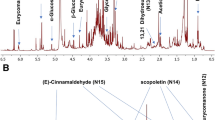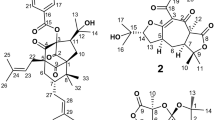Abstract
Eight compounds were isolated from the roots of Garcinia polyantha, and identified. Two of them, the xanthone garciniaxanthone I (1), and the triterpene, named garcinane (2), are reported as new natural products. The structures of the new compounds were elucidated on the basis of 1D and 2D NMR spectroscopic studies. The structure of compound 1 was confirmed by X-ray crystallography. Among the remaining six known compounds, three were known xanthones [smeathxanthone A (3), smeathxanthone B (4), and chefouxanthone (5)], one benzophenone [isoxanthochymol (6)], one triterpene [magnificol], and one sterol [β-sitosterol]. The in vitro antimalarial activity of isoxanthochymol (6) against Plasmodium falciparum shows strong chemosuppression of parasitic growth.
Similar content being viewed by others
Log in or create a free account to read this content
Gain free access to this article, as well as selected content from this journal and more on nature.com
or
References
Kanda P, Pongcharoen W, Phongpaichit S, Walter CT . Tetraoxygenated xanthones from the fruits of Garcinia cowa. Phytochemistry 67: 999–1004 ( 2006)
Deachathai S, Mahabubarakam W, Phongpaichit S, Taylor WC, Zhang YJ, Yang CR . Phenolic compounds from the flowers of Garcinia dulcis. Phytochemistry 67: 464–469 ( 2006)
Komguem J, Meli AL, Manfouo RN, Lontsi D, Ngounou FN, Kuete V, Kamdem WH, Tane P, Ngadjui BT, Sondengam BL, Connelly JD . Xanthones from Garcinia smeathmannii (Oliver) and their antimicrobial activity. Phytochemistry 66: 1713–1717 ( 2005)
Rukachaisirikul V, Adair A, Dampawan P, Taylor WC, Turner PT . Lanostanes and friedolanostanes from the pericarp of Garcinia hombroniana. Phytochemistry 55: 183–188 ( 2000)
Nilar LH, Nguyen D, Ganpathi V, Sim KY, Harrison LJ . Xanthones and benzophenones from Garcinia griffithii and Garcinia mangostana. Phytochemistry 66: 1718–1723 ( 2005).
Williams RB, Hoch J, Glass TE, Evans R, Miller JS, Wisse JH, Kingstone DGI . A Novel Cytotoxic Guttiferone Analogue from Garcinia macrophylla from the Suriname Rainforest. Planta Med 69: 864–866 ( 2003)
Ampofo AS, Waterman GP . Xanthones from three Garcinia species. Phytochemistry 25: 2351–2355 ( 1986)
Brehaut J . Flore illustré du Sénégal. Gouvernement du Sénégal, ministère du développement rural et de l'hydraulique, direction des eaux et forêt, Dakar, pp. 89–90 ( 1975)
Bruker . SMART (Version 5.62), SAINT (Version 6.02). Bruker AXS Inc., Madison, Wisconsin, USA ( 2002)
Sheldrick G M A short history of SHELX. Acta Cryst A64: 112–122 ( 2008)
Andrade-Neto VF, Goulart MOF, Filho JFS, Silva MJ, Pinto MCFR, Zalis MG, Carvalho LH, Krettli AU . Antimalarial activity of phenazines from lapachol, β-lapachone and its derivatives against Plasmodium falciparum in vitro and Plasmodium berghei in vivo. Bioorg Med Chem Lett 14: 1145–1149 ( 2004)
Moloney MB, Pawluk AR, Ackland NR . Plasmodium falciparum growth in deep culture. Trans R Soc Trop Med Hyg 84: 516–518 ( 1990)
Trager W, Williams J . Extracellular (axenic) development in vitro of the erythrocytic cycle of Plasmodium falciparum. Proc Natl Acad Sci USA 89: 5351–5355 ( 1992)
Singh S, Puri SK, Singh SK, Srivastava R, Gupta RC, Pandey VC . Characterization of Simian Malarial Parasite (Plasmodium knowlesi)-induced Putrescine Transport in Rhesus Monkey Erythrocytes. J Biolog Chem 272: 13506–13511 ( 1997)
Meli AL, Komguem J, Ngounou FN, Tangmouo JG, Lontsi D, Ajaz A, Choudhary MI, Ranjit R, Devkota KP, Sondengam BL . Bangangxanthone A and B, two xanthones from the stem bark of Garcinia polyantha Oliv. Phytochemistry 66: 2351–2355 ( 2005)
Markan KR . Gentian pigments—II: Xanthones from Gentiana bellidifolia. Tetrahedron 21: 1449–1452 ( 1965)
Xu JY, Lai YH, Imiyabir Z, Goh SH . Xanthones from Garcinia parvifolia. J Nat Prod 64: 1191–1195 ( 2001)
Mathe C, Culioli G, Archier P, Vieillescazes C . Characterization of archaeological frankincense by gas chromatography-mass spectrometry. J Chromatogr A 1023: 277–285 ( 2004)
Nicollier G, Thompson AC . A new triterpenoid saponin from the flowers of Melilotus alba, white sweet clover. J Nat Prod 46: 183–186 ( 1983)
Doddrell DM, Khong PW, Lewis KG . The stereochemical dependence of 13C chemical shifts in olean-12-enes and urs-12-enes as an aid to structural assignment. Tetrahedron Lett 27: 2381–2384 ( 1974)
Leo MD, Tommasi ND, Sanogo R, D'Angelo V, Germano MP, Bisignano G, Braca A . Triterpenoid saponins from Pteleopsis suberosa stem bark. Phytochemistry 67: 2623–2629 ( 2006)
Mencherini T, Picerno P, Scesa C, Aquino R . Triterpene, antioxidant, and antimicrobial compounds from Melissa officinalis. J Nat Prod 70: 1889–1894 ( 2007).
Granados G, Lopez EP, Melguizo E, Moliz JN, Parra A, Simeo Y . Epoxides, cyclic sulfites, and sulfate from natural pentacyclic triterpenoids: theoretical calculations and chemical transformations. J Org Chem 68: 4833–4844 ( 2003)
Meli AL, Komguem J, Tangmouo JG, Lontsi D, Ngounou FN, Ajaz A, Choudhary MI, Sondengam BL, Rhaman A . Antioxidant benzophenones and xanthones from the root bark of Garcinia smeathmannii. Bull Chem Soc Ethiop 20: 247–252 ( 2006)
Castelli F, Sarpietro MG, Micieli D, Trombetta D, Saija A . Differential scanning calorimetry evidence of the enhancement of β-sitosterol absorption across biological membranes mediated by β-cyclodextrins. J Agric Food Chem 54: 10228–10233 ( 2006)
Rubinstein I, Goad LJ, Clague ADH . The 220 MHz NMR spectra of phytosterols. Phytochemistry 15: 195–200 ( 1976)
Author information
Authors and Affiliations
Corresponding author
Rights and permissions
About this article
Cite this article
Lannang, A., Louh, G., Lontsi, D. et al. Antimalarial Compounds from the Root Bark of Garcinia polyantha Olv.. J Antibiot 61, 518–523 (2008). https://doi.org/10.1038/ja.2008.70
Received:
Accepted:
Issue date:
DOI: https://doi.org/10.1038/ja.2008.70
Keywords
This article is cited by
-
Identification of 3,3′-O-dimethylellagic acid and apigenin as the main antiplasmodial constituents of Endodesmia calophylloides Benth and Hymenostegia afzelii (Oliver.) Harms
BMC Complementary Medicine and Therapies (2021)
-
Epigarcinol and isogarcinol isolated from the root of Garcinia ovalifolia induce apoptosis of human promyelocytic leukemia (HL-60 cells)
BMC Research Notes (2015)
-
The potential of anti-malarial compounds derived from African medicinal plants, part II: a pharmacological evaluation of non-alkaloids and non-terpenoids
Malaria Journal (2014)
-
Cameroonian medicinal plants: a bioactivity versus ethnobotanical survey and chemotaxonomic classification
BMC Complementary and Alternative Medicine (2013)



